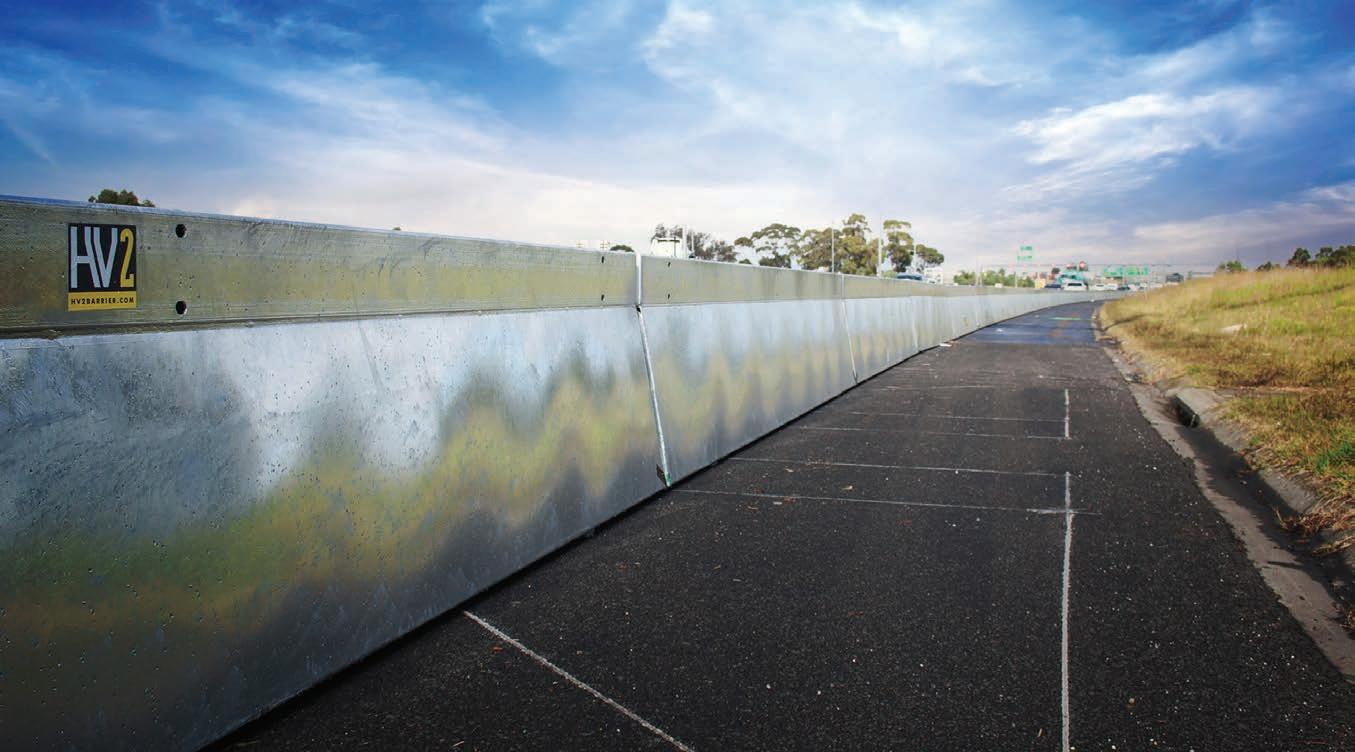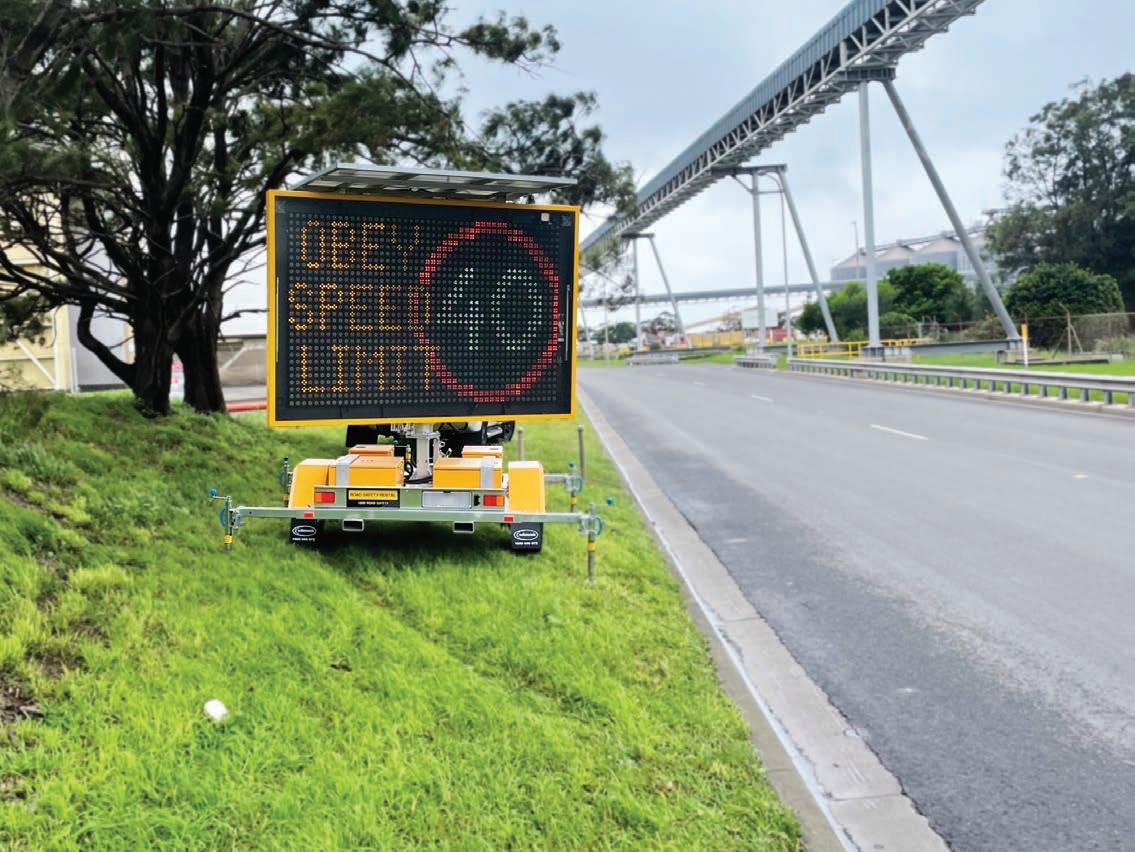
8 minute read
Safety through innovation
With patented hybrid technology, the HV2 Safety Barrier offers high containment and low deflection upon impact.
SAFETY THROUGH
INNOVATION
FOR THE PAST 30 YEARS, SAFEROADS’ INNOVATIONS IN DEVELOPING ROAD AND TRAFFIC SAFETY PRODUCTS HAVE HELPED SAVE MULTIPLE LIVES IN AUSTRALIA AND BEYOND. ROADS & INFRASTRUCTURE LOOKS AT THE COMPANY’S JOURNEY AND HOW THE BUSINESS HAS NOT JUST SURVIVED BUT THRIVED OVER THE PERIOD.
From humble beginnings in 1992 at the tyre shop of its founder Darren Hotchkin to becoming an ASX-listed company with an extensive sales network in the Australian and international road safety market, Saferoads’ journey over the past 30 years has seen both great challenges and extraordinary growth.
This year, the company celebrates its 30th year in business with a product portfolio that’s become known across the industry for being innovative, well-engineered and importantly, trusted for safety and performance. The ups and downs the company has been through over this journey to build that reputation, while bringing all of its research and development and most of its manufacturing in-house, offers lessons in business resilience.
Saferoads began life primarily to commercialise an innovation from Hotchkin himself, which was to produce reboundable guide posts from recycled car tyres.
At the time, guide posts in Australia were made from wood, which was brittle and would fail after only a single vehicle impact. Using recycled tyres meant Saferoads – which was called Rubber Tough Industries then – could produce guideposts that were more durable than timber, while helping divert an end-of-life product from landfill.
Over the next few years, the company used rubber from used tyres to manufacture more traffic-related products, such as speed humps. In its fourth year, Saferoads also began distributing road safety products from a US-based firm across Australia.
By this time, the rubber side of the business became less of a focus and was superseded by the company’s expansion into road safety, barriers, crash cushions, truck-mounted attenuators (TMAs) and many other new products. The Rubber Tough Industries brand was sold, and road safety became the core focus for the company – hence the name change to Saferoads.
In the years that followed, Saferoads expanded its team and established itself as a well-regarded distributor of crash barriers, traffic calming products, lighting and other road safety equipment to the Australian market. In 2003, the company was listed on the Australian stock exchange to attract outside investors, which led to
further growth. A few years later, however, a mid-life crisis threatened the existence of the business.
CHALLENGING TIMES In 2008, Saferoads’ US distributor changed hands and the new owners decided to work exclusively with Saferoads’ competitor, leading to the company losing half of its product range almost overnight.
After the fall-through in relationship with its US distributor, the Saferoads team was faced with tough decisions. Eventually, the company re-located its three-acre factory to a smaller two-acre facility in Melbourne’s south-east suburb of Pakenham, with the team now focusing more intensely on research and development to reduce reliance on foreign imports and owning the intellectual property rights for its innovations.
This shift in focus has led to noteworthy innovations from the company, with Saferoads having had a role in shaping barrier usage on worksites around Australia – and even in other countries such as New Zealand and the US.
The company has also been instrumental in the development, and adaptation by the market, of traffic control and traffic management equipment, such as variable message signs (VMS), TMA trailers, OmniStop portable bollards and more.
Four years ago, Saferoads established Road Safety Rental, a separate rental division within the business that helps the company take its products to market on a hire basis. This division continues to expand its product range and is continually growing.
The company is also still invested in research and development and owns the only dedicated crash testing site for road barriers in Australia.
PIONEERING ACHIEVEMENTS Over the past 30 years, Saferoads has been a pioneer on many fronts, including the introduction of the first hybrid steel and concrete temporary barriers in Australia.
Casey McMaster, Saferoads’ Engineering Manager who has been with the company for almost 19 years, says the company has kept its products up to date with the latest industry requirements.
“The Ironman steel barrier was developed around 2004-2005 based on an innovation by Darren himself, had undergone crash testing in the US and was very popular in both the Australian and the US markets. But as the industry became more mature and started to adopt more stringent safety requirements, we realised that the high deflections in the barrier were no longer appropriate for our current road situations, where construction zones are getting tighter,” says McMaster.
That’s when Hotchkin and the team came up with the idea of putting concrete blocks into the steel barriers to retrofit them and reduce the deflections. This led to the development of Ironman Hybrid barriers, which were successfully crash tested as per the Australian Standard AS3845 and launched to the market.
Last year, Saferoads re-launched the Ironman Hybrid barrier as per the 2009 American Manual for Assessing Safety Hardware (MASH) standard, which was mandated in Australia from the beginning of this year. The new standard required approximately 12 per cent higher impact resistance, which was achieved with slight modifications to the barrier’s terminal connections and crash cushions.
Taking the learnings from the hybrid

The Saferoads R&D team has been working on new trailer designs for the company’s variable message signs.
technology, Saferoads then began working on another traffic barrier called the HV2. This barrier uses the same concept of adding concrete ballast to hollow steel barriers but feature a different design from the Ironman Hybrid.
McMaster says using finite element analysis techniques by utilising the LS-DYNA software has helped Saferoads move its products from the prototype phase to product development more efficiently.
“We use finite element analysis substantially for all our crash tested products. It’s an amazing tool that we run in-house. When we did the HV2 barrier tests in Texas, it cost us around $300,000 to run the three tests, but thanks to the LS-DYNA work that we had done and the resulting design improvements, the barriers passed all requirements on the test day.”
The HV2 barrier was also recently approved by the Austroads Safety Barrier Assessment Panel (ASBAP) and certified for traffic speeds up to 100 kilometres per hour.

TAKING ON FEEDBACK The Saferoads research and development team is constantly reviewing its products based on feedback it receives from customers, and more recently, from the state managers and product managers in its in-house rental division.
An example is the design changes the company is introducing for its VMS trailers. Having started by distributing VMS imported from overseas, Saferoads has eventually taken ownership of the design and manufacture of the trailers, as well as owning the CPU and the IP for the communication platform. These steps, McMaster says, reduce the company’s reliance on overseas support, giving better assurance of safety and reliability to Saferoads’ clients.
This year, the team has been working on modifications to the VMS trailer deign, making them more portable, cost-effective and less prone to vandalism and theft. These design updates, McMaster says, are examples of how the company maintains its edge in the market.
“There’s no point developing a new product that’s already available in the market,” he says. “You need to have an edge, and that comes from making products that are cheaper to manufacture, cheaper to deploy and have better performance.”
Having started out in the industry with tyre recycling, Saferoads has also come full
Saferoads’ Ironman was the first Australian hybrid barrier to combine heavy-duty steel components with concrete ballast.
circle as it is currently collaborating with the Melbourne University and Tyre Stewardship Australia on a project involving use of crumbed rubber from used tyres in T-LOK concrete barriers. The prototype barriers, which will be soon tested at Saferoads’ dedicated crash testing facility in Victoria, are expected to extend the longevity of T-LOK barriers and improve energy absorption, as McMaster explains.
“The rubber from the tyres can absorb a lot of the impact when the concrete barriers are transported from site to site, reducing the risk of breakage and cracking. If we can extend the average service life of T-LOK barriers from approximately three to five years to, say, five to ten years, that’s a considerable saving for the industry,” he says.
PASSION FOR IMPROVEMENT Looking back at the company’s 30-year journey, Hotchkin believes a shared passion for innovation and constant improvement is what helped the company not just stay afloat through its turbulent times, but to thrive and grow to where it stands today.
“Passion for the industry, passion for the company and the desire to continually improve and innovate is something that’s in our DNA as a company,” he says. “Being a relatively small team that’s involved in research and development means we can test out new ideas, take feedback from our sales and rental teams and design products that solve the industry’s issues for road safety.”
Trent Loveless, Saferoads’ Chief Operating Officer, agrees. “We work in an industry that continues to challenge companies like us to innovate and find ways to improve the performance of our products,” says Loveless.
“SafeRoads, by its roots, has evolved through constant innovations, bringing in new products, new concepts and finding solutions to fill the gaps in the market. Our work is not done, and our list of innovations and potential R&D continues to grow.”
Hotchkin sees it as a positive sign that the industry is becoming more mature and more stringent with safety regulations.
“I think as a company, we’ve moved with the tightening of the regulations, and we see it as a positive thing, because it removes a lot of companies that don’t want to comply with the more stringent regulations of products,” he says.
And what does the journey ahead look like for Saferoads?
“We want to continue on a similar path of bringing a couple of new innovative products to the market every year, while having a solid foundation for the business so that we can attract the right sort of people. There’s a saying, ‘your people are your best and worst assets,’ so if we can attract innovative, openminded, hardworking and passionate people to the business, we can achieve much better results,” says Hotchkin.
“The goal is to have innovative products that make the roads safer. I believe having a solid, stable business and the right culture that’s collaborative and open will help us get there.”











